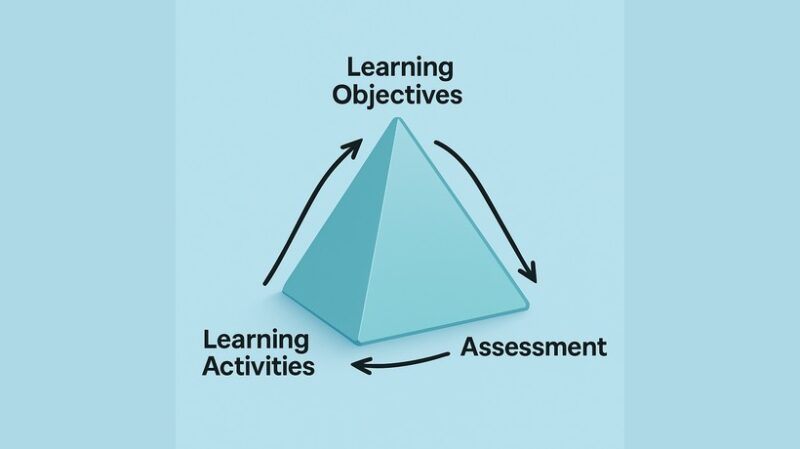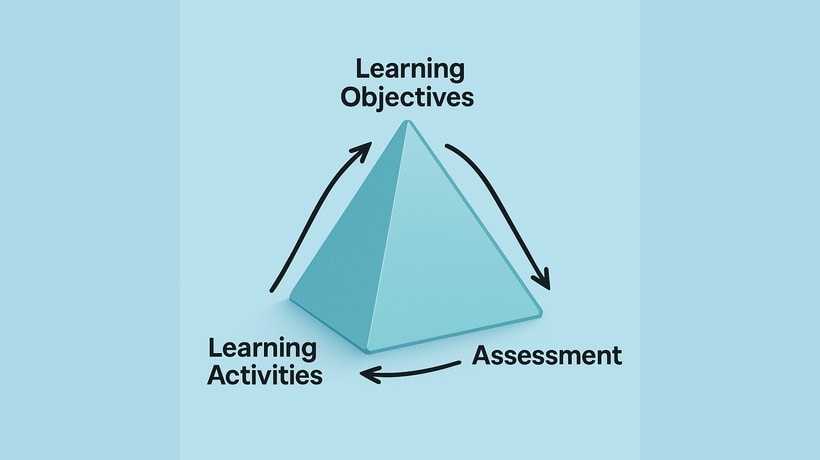
What is the magic triangle of learning?
Have you ever wondered why some training programs succeed, while others are not? This happened to most people: to finish a course, get a certificate, but not remember anything later. On the other hand, there are training experiences that stick and leave people to apply what they have learned for a long time. So what's the difference? All this has to do with the structure of a course. And this is where the magic triangle of learning comes into play.
This framework combines three key elements that each effective learning experience should have: learning objectives, activities and assessments. When the three are aligned, learning becomes clear, determined and memorable. To give more meaning, imagine a triangle, with arrows flowing between each point. The objectives shape your activities, the activities prepare learners for assessments and evaluations show if your objectives have been achieved. The idea has its roots in educational conception, especially in constructive alignmentA term popularized by education theorist John Biggs. It is widely used both in academic contexts and training as a workplace, and it is because it is effective. Let's see how the magic triangle of learning works, especially in Elearning.
The 3 pillars of the magic learning triangle
Pillar 1: Learning objectives
Learning objectives are the secret of each course or well -designed training program. Without them, the learners do not know where they are heading and the instructors risk creating courses that do not lead anywhere. Learning objectives are clear and measurable declarations that highlight exactly what learners should be able to do by the end of a session or a module. When you develop your own objectives, try to use active verbs, such as “identify”, “create”, “apply” or “analyze”. In addition, keep them focused on learners, as they will do and not what you will teach them. Finally, always align them with wider objectives, whether for a business, compliance or a personal development plan.
Pillar 2: learning activities
Learning objectives tell us what learners should know or do, but learning activities are how they get there. These are practical experiences that help learners to absorb, apply and keep new information. It can be group discussions, interactive elearning modules, case studies, game exercises or games. The goal is to create opportunities where learners interact with information, not just receiving it. However, not all activities are the same. In order for them to be really effective, they must be linked to your learning goals. For example, if your goal is to help someone manage conflicts at work, a role -playing scenario or a simulation will have more impact than a quiz. You should also keep in mind that different people learn in different ways. Thus, including various types of activities helps to ensure that everyone remains committed and gets something significant of experience.
Pillar 3: Evaluation
Thus, you have set clear learning objectives and designed engaging activities. Now, how do you know if all of this was really effective? Through the evaluations, which are the third pillar of the magic learning triangle. The evaluations differ, but at the base, these are only tools to verify whether the learners have achieved your objectives. There are two main types: formative and summary. Formative assessments are like learning control points, such as short quizs, discussion prompts or comments during activities. They help learners stay on the right track. Summary assessments, on the other hand, occur at the end, such as final projects, presentations or skills demonstrations. These are more like the effectiveness of learning. Again, the key to a significant evaluation is alignment. Your questionnaires, assignments or tests must attach directly to the objectives that you set at the beginning.
What happens when the 3 pillars line up?
So what does it really happen when learning objectives, activities and evaluations all line up? Learning becomes clear, useful and effective. First of all, it arouses motivation. Knowing exactly what to do, how it connects to objectives and what it takes to achieve success makes learners more confident. They are impatient to engage with the content because they know that it is relevant and plays a role in the way they will be assessed. For Educational designersIt rations the entire design process. When the objectives are clear, the choice of good activities and the design of evaluations that really matter is easier.
What is happening in the event of a disalcher?
Even the best learning programs can fail if part of the triangle is deactivated. Unfortunately, this often happens. A common problem is when activities feel disconnected from learning objectives. If learners cannot see how an activity helps them achieve the goal, engagement drops, and they don't really learn. Then there are also evaluations that do not correspond to what has been taught. It can be frustrating for learners. They could spend hours learning a concept through videos and examples, to be tested on something completely different or theoretical. The learners are confused when the objectives, the activities and the evaluations are not synchronized. It seems unfair and it is not good for retention.
How to put it into practice in Elearning
Clear objectives
To create clear goals for your Elearning course, instead of generic goals, use usable, measurable instructions and do not allow to guess. In this way, the learner knows exactly what is expected and educational designers know exactly what to build.
Targeted activities
In Elearning, you must be a little more creative when you design significant activities. Instead of passive methods, such as slides, conferences or videos, use interactive activities with real relevance. For example, the scenarios where learners make decisions and see results, stories or simulations.
Significant assessments
Many Elearning assessments only test recall knowledge, not its application. But in the real world, learners must be able to do things with what they have learned. To make the evaluations significant, ask if the test shows if the learner can really reach the goal. For example, if the objective is to learn to execute a Google Ads campaign, it would be more significant to award them a project where they would create and put a simulated campaign.
Use of data and analysis
One of the greatest advantages of digital learning is data. You can see what the learners click on, how long they spend on each course, where they deposit and what they are most often wrong. But you need to learn to use it. If you notice that learners are wrong with a specific activity, see what you can improve. Likewise, if learners abandon a special course or section, try to make it more engaging.
Conclusion
That you create a university course, a Business training programOr an online module, the magic learning triangle can help you keep on the right track. When your objectives, activities and evaluations are all synchronized, learning has an impact. Your learners develop, develop skills and really gain something they can use. Try to start conceiving with the triangle in mind, and you will notice that you wouldn't do it otherwise.


